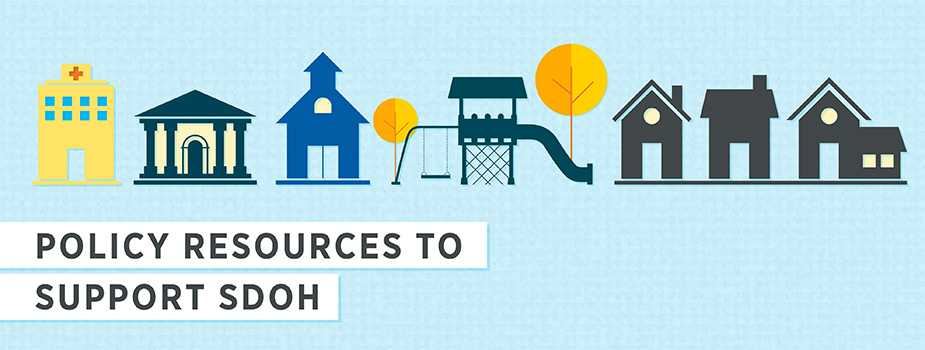Policy Resources to Support SDOH

This section of the SDOH website includes resources on policies that support a multi-sector approach to improving health. Together, people who work in public health, health care, and non-health fields can take actions that target high-priority SDOH. The following resources help identify and describe policy opportunities and involve other sectors to improve health and well-being:
-
Brownfields/Land Reuse Action Model
- The Brownfields/Land Reuse Action Model helps diverse members of the development community—officials, developers, community supporters, and residents—find ways to work together and show how health can be part of a community’s renewal process. The model uses a four-step process to identify and incorporate common goals into strategic planning.
-
Chronic Disease State Policy Tracking System
- The Chronic Disease State Policy searchable database contains more than 6,000 enacted and introduced state policies related to chronic disease prevention and health promotion. Many of these policies include multi-sector approaches such as access to healthy foods in communities, farm-direct foods, physical activity requirements, and public transportation.
-
CDC Community Health Improvement (CHI) Navigator
- CDC’s CHI Navigator helps hospitals, health systems, public health agencies, and community organizations from a variety of sectors improve community health. Prompted by the Internal Revenue Service requirement for tax-exempt hospitals to assess community health needs, CHI Navigator makes the case for prevention, provides evidence-based interventions, and offers a unifying framework that can move partnerships from planning to action.
-
Health Impact Assessment: Stories from the Field
- The Health Impact Assessment (HIA) website contains success stories from health departments using HIA in collaboration with urban planning professionals to develop healthier places. HIA helps public and planning professionals evaluate the potential health effects of a plan, project, or policy before it is built or carried out. HIA brings potential public health impacts and considerations to the decision-making process for plans, projects, and policies that fall outside of traditional public health topics, such as transportation and land use.
- The Health Impact in 5 Years (HI-5) initiative
- The Health Impact in 5 Years (HI-5) Initiative highlights 14 non-clinical, community-wide approaches that have evidence reporting 1) positive health impacts, 2) results within five years, and 3) cost effectiveness and/or cost savings over the lifetime of the population or earlier. Programs that address the conditions in the places where we live, learn, work, and play have the greatest potential for keeping people healthy. By focusing on these “social determinants of health” (SDOH) and on “changing the context to make healthy choices easier,” we can help improve the health of everyone living in a community. To assist in changing this perception CDC developed HI-5 - this short list of proven community-level health interventions to assist states, communities, and health systems improve population health and well-being. Examples of HI-5 interventions that address SDOH include public transportation system expansion, home Improvement loans and grants and early childhood education.
-
Health in All Policies: Achieving National Prevention Strategy and Healthy People 2020 Goals
- Health in All Policies (HiAP) is a collaborative approach that integrates health into policy-making across sectors to improve the health of all communities and people. HiAP recognizes that health is created by a multitude of factors beyond health care. This site contains resources on HiAP as an approach to achieving National Prevention Strategy and Healthy People 2020 goals.
-
Urban Design and Transportation Policies and Practices
- The Urban Design and Transportation fact sheet provides examples of state efforts to prevent and control obesity and other chronic diseases through healthful eating and physical activity. This approach looks at urban design and transportation policies and practices, especially those that encourage walking, bicycling, and public transportation.
For questions or additional information, email healthpolicynews@cdc.gov.
- Page last reviewed: February 22, 2017
- Page last updated: February 22, 2017
- Content source:


 ShareCompartir
ShareCompartir